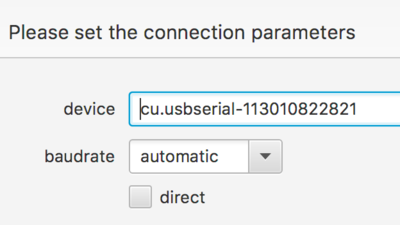Difference between revisions of "Help/SerialConnection"
Jump to navigation
Jump to search
| Line 3: | Line 3: | ||
[[File:serialParams.png|400px]] | [[File:serialParams.png|400px]] | ||
| + | {| class="wikitable" | ||
| + | |- | ||
| + | ! item !! hint | ||
| + | |- | ||
| + | | device|| the name of the device depends on your computer's operating system (see below) | ||
| + | |- | ||
| + | | baud rate || the speed of the connection or automatic if typical baudrates shall be tried see | ||
| + | https://www.scantool.net/blog/switching-communication-baud-rate/ | ||
| + | |- | ||
| + | | direct || check if the access to the device should be done directly with out a serial driver | ||
| + | |} | ||
== device == | == device == | ||
=== Windows === | === Windows === | ||
| Line 20: | Line 31: | ||
== Baudrate == | == Baudrate == | ||
| − | |||
| − | |||
Revision as of 12:57, 12 August 2017
You might want to select the serial Connection parameters:
| item | hint |
|---|---|
| device | the name of the device depends on your computer's operating system (see below) |
| baud rate | the speed of the connection or automatic if typical baudrates shall be tried see
https://www.scantool.net/blog/switching-communication-baud-rate/ |
| direct | check if the access to the device should be done directly with out a serial driver |
device
Windows
typical connection devices are:
- COM1
- COM2
- ...
Linux
typical connection devices are
- ttyUSB0
- ttyUSB1
- ...
Mac OS
typical connection devices are:
- cu-usbserial
- cu-usbserial-####
